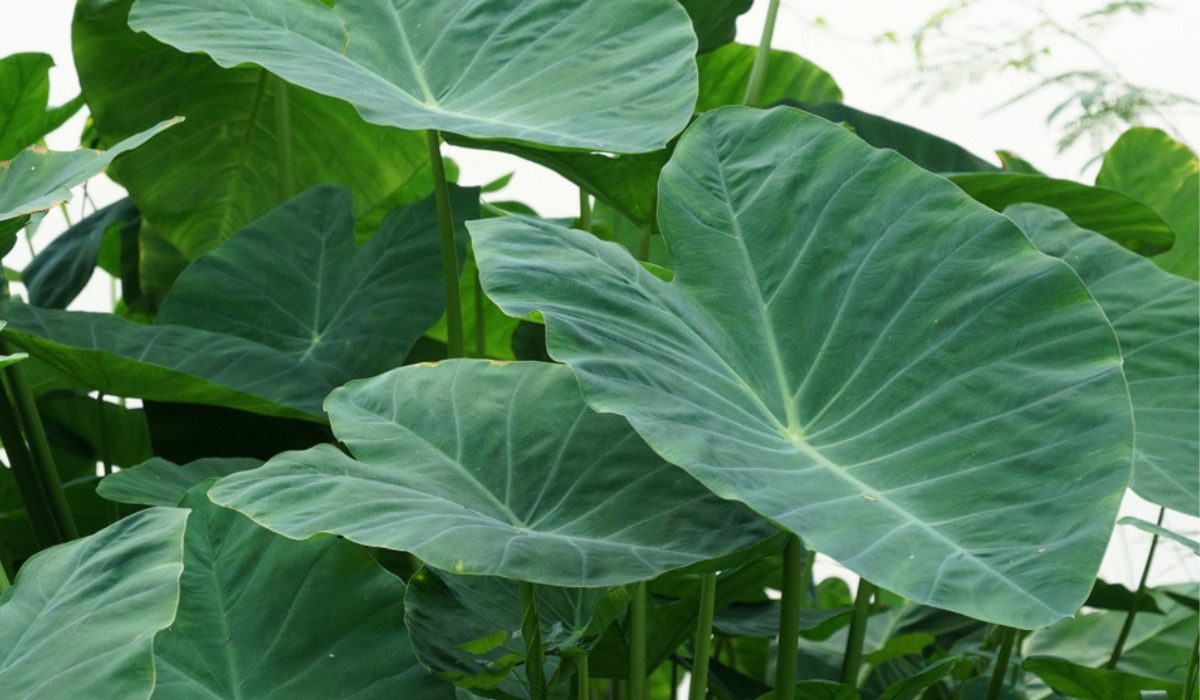The Elephant Ear Plant Red, known scientifically as Colocasia esculenta ‘Red Stem’, captivates with its striking foliage and vibrant hues. Originating from Southeast Asia, this tropical gem boasts impressive leaves that resemble elephant ears, adding a touch of exotic elegance to any space.
With its distinctive burgundy-red stems and veins that contrast against its deep green leaves, the Elephant Ear Plant Red stands out as a focal point in any garden or indoor setting.
Botany and Characteristics: Elephant Ear Plant Red

The Elephant Ear Plant Red, scientifically known as Colocasia esculenta ‘Red Stem’, is a striking ornamental plant native to Southeast Asia. It is a member of the Araceae family, known for its large, shield-shaped leaves that can grow up to 3 feet in length.
The Red Elephant Ear stands out with its distinctive reddish-brown stems and leaf veins. The leaves are typically dark green, with a velvety texture and prominent veins that give them a unique crinkled appearance. The plant can reach a height of 4-6 feet, making it a focal point in any garden.
Origin
The Elephant Ear Plant Red is native to tropical and subtropical regions of Southeast Asia, including India, Thailand, and Malaysia. It has been cultivated for centuries as a food source and for its ornamental value.
Physical Attributes
– Large, shield-shaped leaves with a velvety texture
– Reddish-brown stems and leaf veins
– Height of 4-6 feet
– Rhizomatous root system
– Perennial in warm climates, but can be grown as an annual in cooler regions
Cultivation and Care

Cultivating and caring for the Elephant Ear Plant Red is not a challenging task, provided its specific requirements are met. By understanding its optimal growing conditions, planting, propagation, and maintenance needs, you can ensure a healthy and thriving plant.
Soil Requirements
Elephant Ear Plant Red prefers well-drained, moist, and organically rich soil. A mixture of loam, peat moss, and compost creates an ideal growing medium that provides the necessary nutrients and moisture retention.
Light Exposure, Elephant ear plant red
These plants thrive in partial shade to full shade. Direct sunlight can scorch the leaves, especially during hot afternoons. Morning sun or dappled shade is ideal for optimal growth.
Watering Needs
Elephant Ear Plant Red has a high water demand, particularly during the summer months. Keep the soil consistently moist but avoid overwatering, which can lead to root rot. Water deeply and allow the top few inches of soil to dry out before watering again.
Planting
Plant Elephant Ear Plant Red in spring or early summer after the last frost. Dig a hole twice the width of the root ball and just as deep. Place the plant in the hole and backfill with soil, gently firming it around the base. Water thoroughly after planting.
Propagation
Propagation can be done through division or by seed. Division is the easiest method, where you can separate the offsets or “pups” that form around the base of the mother plant. Seed propagation is more challenging but can be attempted by sowing seeds in a warm, moist seedbed.
Maintenance
Regularly remove spent leaves and flowers to promote new growth. Fertilize monthly during the growing season with a balanced fertilizer. Mulch around the plant to retain moisture and suppress weeds.
Uses and Applications

The Elephant Ear Plant Red is a versatile plant with numerous ornamental and practical applications. Its striking foliage makes it a popular choice for landscaping and gardening, while its large leaves offer practical benefits as well.
In landscaping, the Elephant Ear Plant Red can be used as a focal point in borders, beds, and containers. Its large, colorful leaves create a dramatic effect, adding a touch of tropical flair to any garden. The plant is also suitable for creating privacy screens or hedges, as its dense foliage can effectively block unwanted views.
In Home Decor
- The large leaves of the Elephant Ear Plant Red can be used to create stunning indoor arrangements. They can be placed in large vases or pots as standalone pieces or combined with other plants to create a lush, tropical display.
- The leaves can also be used as a backdrop for smaller plants, adding a touch of drama and interest to any indoor space.
In Floral Arrangements
- The large, colorful leaves of the Elephant Ear Plant Red can be used to add a touch of drama and elegance to floral arrangements. They can be paired with other tropical flowers, such as orchids or anthuriums, to create a stunning display.
- The leaves can also be used as a base for floral arrangements, providing a lush, tropical foundation for other flowers and greenery.
Other Uses
- The leaves of the Elephant Ear Plant Red are also used in traditional medicine. They are believed to have anti-inflammatory and pain-relieving properties.
- The leaves can also be used as a natural insect repellent. They contain compounds that are known to repel mosquitoes and other insects.
/elephant-ear-plants-2132884-15-c8a2fff099f24f75b9d7c69dc0caa0e0.jpg)